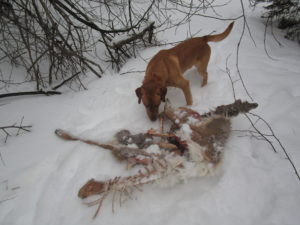They say every wolf has a raven. Maybe so, because I once watched a raven closely follow a wolf as it ambled up someone’s driveway. Here on the North Shore, there are more than enough ravens to go around. I hear them croak as they pass overhead nearly every morning when I step outside with my dogs. Their presence is a constant in my life.
Aside from road kills and deer season gut piles, ravens are unconcerned with the ways of man. They soar above our world, commenting on what passes beneath them with a strange vocabulary of croaks and squawks. Wary and aloof, rarely do they land in a tree or on the ground anywhere near a human. That’s why I was surprised by the behavior of the neighborhood ravens last weekend.
I was walking the dogs on an old logging road near my home last Saturday. Rainy, the young Lab, was out in the lead, as usual. Suddenly, a passing raven spotted him, wheeled and swooped over him just above the tree tops. Then it landed in a tall aspen. It took to the air again as I approached, but kept following Rainy. Soon it was joined by a second raven.
The first raven landed again in an aspen. This time it let me walk underneath it. Rainy and Tanner, my older Lab, followed a deer trail into the woods. Soon Rainy returned, proudly carrying a deer skull in his mouth. The raven became airborne and was obviously interested in this new development. It stayed with us as we walked a couple of hundred yards out to the county road. Then it perched in an aspen beside the road while the second raven circled overhead. They followed us the rest of the way home.
I let Rainy keep the deer skull to gnaw on. It was relatively fresh and had been picked clean by scavengers. But it would keep the young Lab occupied for a day or two.
When I let the dogs out at daybreak Sunday morning, Rainy went straight for his deer skull and carried it across the yard. Within seconds, a raven appeared overhead and then landed in a tall tree. It was quickly joined by two other ravens, circling and croaking over my yard. One made an acrobatic twist in flight and was momentarily illuminated by the first rays of the morning sun. For an instant, the black bird appeared to be edged with fire. This time, the ravens didn’t hang around. They must have figured out that Rainy wasn’t going to lead them to their next meal.
When we went for a walk later in the day, I followed the dogs down the deer trail where Rainy found the skull. The remains of a large deer were lying on top of the snow. Little was left except for the hide and parts of the skeleton. I’m not sure how it died, because fresh snow had covered up any tracks. I’d heard wolves in that vicinity about three weeks previous. But I’m not sure it was a wolf kill.

The ravens were aware of the carcass. And Rainy resembled a wolf. That’s why they were interested in him. I’ve often seen where wolves have taken a hunk from a carcass and carried it away from the kill site to eat it. That’s essentially what Rainy did when he took the deer skull. I was surprised at how quickly they found him when we stepped outside the following morning. But ravens are ever-present in our neck of the woods.
As is often the case in the natural world, I was just a bystander to the interaction between dog and bird. Rainy gave no indication that he was aware of the raven. I doubt that his awareness mattered much to either of them. The raven was simply looking for its next meal.
Although the raven looks like a large crow, all similarity seems to end there. Crows are raucous, enjoy the company of their kind and, in a world where they are no longer shot on sight, have adapted to living among humans. They are surprisingly intelligent and may even seem to have a sense of humor. But they are not ravens.
Something about the raven suggests it is an ancient bird with an intelligence better described as wisdom. While ravens do gather at a kill, they most often are seen flying alone or in pairs, relentlessly seeking food. Ravens seem to find joy in flight. I’ve seen them do barrel rolls, apparently for no other reason than they can do it. Two ravens in flight, especially during the mating season, can appear to be performing a dance in the sky. They twist and pirouette, following one another through complicated moves. If there is a bird that epitomizes the spirit of flying, it’s the raven.
If indeed every wolf has a raven, then it’s also true they have an ancient connection with humans. No doubt they were present when the first hunters killed a woolly mammoth. They were there as well for the slaughter of American bison. And when the fighting ended on the battlefield, they were there, too. The raven has a role to play in this world and it does so with impartiality.
I saw the ravens at the Tower of London. I’ve encountered them in lonely places far from home. The raven is a familiar presence in my daily life, yet it remains inscrutable. I know the raven. But I don’t really know it all.

